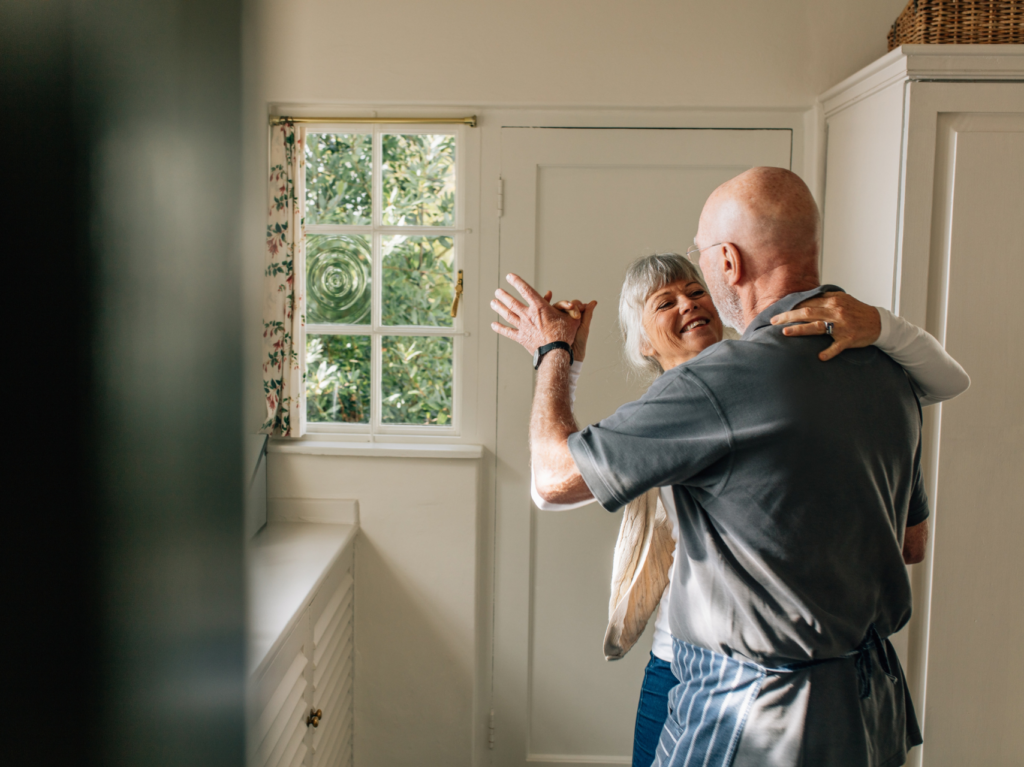Table of Contents
Picture this: you’ve worked hard, invested in your home and life, and now it’s time for your property to start giving back. This is where a reverse mortgage may come in–a program that can help older adult homeowners unlock the equity in their homes. But what exactly is a reverse mortgage? It’s like having a hidden stash of cash in your house that you can access when you need it. But there’s a lot of confusion about reverse mortgages. Some people worry they’ll lose their home or burden their family members with debt. In reality, you keep your home with a reverse mortgage and the loan doesn’t have to be paid back until you leave. Your family won’t be left with a mountain of debt either. In this blog, we’ll clear up the confusion and see how reverse mortgages can open up new financial possibilities.
We’ll cover the various types of reverse mortgages, debunk common myths, and share their potential benefits. Whether you’re seeking to sustain your retirement income or finance a dream project, reverse mortgages offer a flexible solution to tap into your home equity. We’ll help you learn how to take advantage of reverse mortgages for financial security and peace of mind.
Understanding Reverse Mortgages
A reverse mortgage offers a unique way for older homeowners to leverage their home equity. Unlike traditional mortgages where you make monthly payments to the lender, with a reverse mortgage the lender pays you. It’s like turning your home into a personal ATM, allowing you to access funds for various expenses without selling your home. However, eligibility criteria for reverse mortgages differ in the sense that you…
- Must meet the age requirements
- Live in the property as the primary resident
- Have paid and continue to pay property taxes and homeowner’s insurance
These criteria ensure that reverse mortgages are tailored to meet the needs of retirees and older adults looking to supplement their income or cover expenses in their golden years. By tapping into their home equity, homeowners can fund home improvements, cover medical expenses, or simply enjoy a more comfortable retirement. With the flexibility of not having to make monthly payments and the option to receive funds as a lump sum, line of credit, or monthly payments, reverse mortgages provide financial freedom for those looking to unlock the value of their homes.
Types of Reverse Mortgages
Imagine your home not just as a place to live, but as a source of financial freedom. That’s where a reverse mortgage may come in. Let’s review the types of reverse mortgages available and see how they align to your financial goals.
Home Equity Conversion Mortgages (HECMs)
Home Equity Conversion Mortgages (HECMs) are the most common type of reverse mortgage. HECMs, backed by the FHA, offer homeowners aged 62 and older a pathway to tap into their home equity for cash, monthly payments, or a line of credit.
With a HECM, you retain ownership of your home while accessing its value, but there are rules to follow. You must live in the home, maintain it, and cover all property charges. Within HECMs, there are two main options: fixed-rate and adjustable-rate.
Fixed-Rate HECM
Fixed-rate HECMs provide stability in uncertain times. You lock in your interest rate for the life of the mortgage, offering peace of mind and predictability. However, the drawback is that you must take a lump sum withdrawal at closing, which can allow interest to accrue faster and limit your available funds.
Adjustable-Rate HECM
On the other hand, adjustable-rate HECMs have been the crowd favorite among many homeowners over 62. Your rate is determined by adding a margin and an index, typically the Constant Maturity Treasury (CMT). This option offers flexibility, allowing funds to be paid out as a lump sum, line of credit, tenure payment, or any combination.
A HECM reverse mortgage offers versatility, serving to refinance your existing home or to finance the purchase of a new one. Additionally, it’s possible to refinance an existing HECM into a new one, unlocking additional funds, contingent upon passing a net benefit test, which will ensure the property enough equity so you will benefit from a reverse mortgage.
Proprietary Reverse Mortgages
But what if your home’s value exceeds the limits of a traditional HECM? Consider proprietary reverse mortgages, also known as Jumbo reverse mortgages. These cater to homeowners with higher-valued properties, offering access to more equity or the ability to purchase a pricier home. Jumbo reverse mortgages carry fewer restrictions, can be used for non-FHA approved condos, and boast lower closing costs without mortgage insurance.
Moreover, Jumbo reverse mortgages offer Fixed and Adjustable-rate options, complete with a line of credit. Plus, you can start as early as age 55. However, be aware that rates may be higher compared to traditional HECMs.
Whether you’re looking to support your retirement funds, make home improvements, or simply enjoy a more comfortable lifestyle, there are several types of reverse mortgages that can be tailored for any retired lifestyle.
Benefits of Reverse Mortgages
With the rising costs of living and uncertain economic conditions, many older adults find themselves facing financial challenges in retirement. Luckily, a reverse mortgage provides several benefits that make retirement more comfortable, such as:
Supplementing Retirement Income
A reverse mortgage provides a reliable source of funds without the need to sell their home or rely solely on retirement savings. Some may use the additional income from a reverse mortgage to cover monthly expenses, medical bills, or unexpected emergencies, stabilizing their finances through any surprises during retirement.
Maintain Homeownership
One of the most significant advantages of a reverse mortgage is the ability to maintain homeownership while accessing home equity. For many, the home represents more than just a place to live—it’s a sanctuary filled with memories and emotional attachment. With a reverse mortgage, homeowners can tap into their home’s equity to address financial needs without having to sell or downsize. This means they can continue living in the comfort and familiarity of their own home, preserving their independence and quality of life well into their retirement years.
Flexibility in Funds
Furthermore, reverse mortgages offer unparalleled flexibility in how funds can be used. Borrowers have the freedom to use the proceeds as they see fit, such as home renovations, paying off existing debts, or funding dream vacations. This flexibility empowers adults over 55 to address their unique financial goals and priorities, providing a sense of control and security over their finances.
With the ability to customize their financial strategy according to their individual needs, reverse mortgages offer a versatile solution for retirees looking to make the most of their home equity.
Important Factors to Keep in Mind
While reverse mortgages offer various benefits, it’s important to acknowledge potential drawbacks:
Interest Accrual and Loan Repayment
One of the standout benefits of a reverse mortgage is the freedom from monthly mortgage payments. Instead, the interest due on your loan balance is deferred and added to your loan balance until the last borrower moves out or passes away. Over time, your loan balance grows depending on borrowed amounts and accrued interest.
When the last borrower leaves the home or passes away, the loan must be repaid. Typically, within six months, heirs have three options: they can refinance or use other means to repay the loan and keep the house, sell the property and repay the loan balance while retaining remaining equity, or deed the home to the servicer if the loan value exceeds the home value, covered by FHA insurance against losses.
Impact on Inheritance
Due to the growing loan balance, the equity left after a reverse mortgage may be less than without one, affecting the inheritance. However, substantial equity often remains, considering potential home appreciation and initial loan caps. Plus, borrowers experience increased independence, reducing financial and time burdens on their family.
Counseling and Education Requirements
Before beginning the mortgage process, all borrowers must undergo independent third-party counseling. This session, typically conducted by phone, ensures borrowers understand their options, reviews their financial situation, and serves as a protective measure in the reverse mortgage process.
When Is a Reverse Mortgage Not a Good Option?
While a reverse mortgage seems like the best idea so far, when is it not a good idea? To be empowered, even in retirement, it is important to recognize reasons not to obtain one. Here are a few reasons why a reverse mortgage may not be the best fit for you.
- The home may not align with long-term needs: If you plan to sell soon or if your home doesn’t suit your future physical requirements, a reverse mortgage may not be suitable. The program is tailored for aging-in-place.
- Limited tangible benefit: If the reverse mortgage doesn’t offer significant current or future advantages, it might not be the best option. Consider alternatives that provide more sustainable solutions for retirement.
- Adult child living arrangements: If an adult child currently resides in the home and can’t afford to refinance out of the reverse mortgage after the homeowner’s passing, it could pose financial challenges.
For additional guidance on whether reverse mortgages are the right financial solution for you, consult with Shanne Sleder.
The Application Process for Reverse Mortgages
Going through the mortgage process, yet again, can bring on feelings of uncertainty and stress. However, it may be easier to manage than a traditional mortgage, especially when you have an expert team on your side! Let’s break the essential steps down.
1. Determining Your Loan Amount
To kick off your reverse mortgage journey, three key pieces of information are crucial: your age, current interest rates, and home value. These factors shape what’s known as the principal limit, or how much money you can access through a reverse mortgage. Generally, the older you are, the more you qualify for. The expected interest rate also plays a role, as does the home’s value or the HECM loan limit, whichever is less.
2. Qualification and Documentation
Compared to traditional mortgages, reverse mortgages have more flexible qualification criteria. They focus less on credit scores and debt-to-income ratios. Instead, a financial assessment ensures you can cover property taxes, insurance, and meet residual income requirements. Lenders require income documentation, proof of insurance, ID, and possibly trust documents and bank statements.
3. Appraisal and Property Evaluation
Once the process is underway, an appraisal is ordered to determine your home’s value and how much money you can access through the reverse mortgage. This evaluation is based on recent sales or comparable homes in the area.
4. Loan Approval and Disbursement
After the appraisal and documentation review, your reverse mortgage gets the green light from the underwriter, typically within 30-45 days. At closing, any existing loans on the property are paid off. You then have the choice to receive additional funds or keep them in a line of credit for future use, putting you in control of your financial journey.
Financial Planning with Reverse Mortgages
Ever wonder how you can make your retirement savings stretch further? Financial planning with reverse mortgages might just hold the answer. With a straightforward approach to leveraging home equity, seniors can find new ways to supplement income and cover expenses.
Budgeting and Cash Flow Management
In retirement, every penny counts. A reverse mortgage can be a game-changer for budgeting and cash flow management when integrated into your financial plan. By paying off existing mortgages or credit card debt, a reverse mortgage can free you from monthly payments. Plus, it offers additional cash flow options through a line of credit or tenure payments, providing financial flexibility and peace of mind.
Long-Term Financial Planning
Planning for the long term? A reverse mortgage can be a valuable tool. It reduces the need to draw from retirement accounts, helping manage sequence of return risks and allowing you to delay taking Social Security benefits. Additionally, it can cover future medical expenses or in-home care, safeguarding your retirement funds for other essentials.
Mitigating Risks and Maximizing Benefits
To ensure you’re getting the most out of your reverse mortgage, seek guidance from experienced mortgage advisors and financial planners. They can tailor a strategy that aligns with your retirement goals and addresses any concerns. Educating beneficiaries about how reverse mortgages work is also important, ensuring a smooth estate transition when the time comes.
Making a Difference for Your Loved Ones
Ever wondered if a reverse mortgage could truly make a difference for your loved ones? Shanne Sleder, a seasoned mortgage advisor who specializes in reverse mortgages, has ample experience working with the older generation to secure a comfortable lifestyle in retirement.
Many times, he is asked, “Would you recommend a reverse mortgage to someone in your family?” and he can say with confidence, yes! A few years ago, he assisted his wife’s grandparents, who were grappling with health issues and accumulating debt from previous mortgages, by guiding them through the process. This debt was adding stress to the situation and made it so that if her grandfather passed away, they were not sure if her grandmother was going to be able to continue to afford to live in the home.
With a reverse mortgage, they were able to eliminate their mortgage and credit card debt, freeing up several thousand dollars a month. Additionally, they used the funds to address deferred home maintenance, allowing them to enjoy their final years without monetary stress. Once her grandfather passed away, her grandmother was able to continue to live in the home and not worry about expenses. She was so happy with how the reverse mortgage helped her during that time.
One of the most significant lessons Shanne has learned over the years working with older adults and reverse mortgages is the importance of not waiting until you need one to apply. By then, it may be too late, as running out of income or assets can make passing the financial assessment more difficult. Falling behind on mortgage, taxes, or insurance payments can also complicate qualification. Additionally, while it’s still possible to get a reverse mortgage if you or your spouse develop health issues, such as dementia, the process becomes much more challenging.

Take Control of Your Golden Years
Reverse mortgages offer seniors a valuable financial tool to tap into their home equity and enhance their financial stability.
By utilizing a reverse mortgage, older adults can access funds to cover expenses, reduce debt, and improve their retirement quality of life. With valuable knowledge and expertise in this area, Shanne Sleder with RWM Home Loans can support your goals to take charge of your financial future with proper guidance and planning. Get in touch today at his website linked below!
What if you want to pay off your mortgage before retirement? Look no further, our blog gives insight into how to pay off one of the biggest debts of your life before you reach your golden years.

About the Guest Author
Shanne Sleder
Shanne specializes in making the loan process easy to understand and fully transparent. He has developed a 3-step process to make sure his client’s loans close on time and they are satisfied. A specialist in Reverse Mortgages, his process not only starts with an in depth consultation, but he makes sure your mortgage needs are taken care of well into the future. Shanne works with many first-time home buyers, move-up clients, and seniors. Learn more.
Financing details are for educational purposes only. All views and opinions do not constitute financial or legal advice and reflect requirements at the time of publication. Rates, program terms, fees, and conditions referenced are subject to change without notice. Not all products are available in all states for all amounts. All mortgage applications are subject to underwriting guidelines and approval. This is not an offer of credit or a commitment to lend. Residential Wholesale Mortgage, Inc. dba RWM Home Loans is an equal housing lender licensed by the CA Department of Real Estate #01174642 and CA Department of Financial Protection and Innovation under the California Residential Mortgage Lending Act. NMLS# 79445






